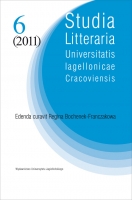Genreekvilibristen Astrid Lindgren
Astrid Lindgren’s genre equilibristics
Author(s): Krzysztof BakSubject(s): Literary Texts
Published by: Wydawnictwo Uniwersytetu Jagiellońskiego
Keywords: Astrid Lindgren; Generic Studies; Swedish literature
Summary/Abstract: The paper examines genre strategies in a number of children’s books by the well-known Swedish author, Astrid Lindgren. Drawing on the reception theories of Hans Robert Jauss, Aidan Chambers and Reinbert Tabbert, the paper demonstrates that the stormy reception of Pippi Longstocking (1945), prompted by a review by Professor John Landquist, had principally genre-related grounds. The book made readers feel a sense of provocation because it challenged their archetextual horizon of expectations by evoking certain traditional genres and simultaneously twisting them in almost anarchic ways. In later books Astrid Lindgren makes a more elaborate use of classic genre structures. She generally chooses one well-known archetext as the generic dominant and allows it to interact with a set of other genres, thus calling forth the main aesthetic effect of the book from the archetextual dialogue between the dominant and the accompanying genres. The paper specifically investigates this polyphonic method in three of Lindgren’s most popular books. In All about the Bullerby children (1947–52) the generic dominant is idyll and the subordinated archetexts satire, parody, burlesque, farce, fairy tale and ballad. Mio, my son (1954) can be considered as an artistic fairy tale (Kunstmärchen), this dominant genre correlating with some other interwoven archetexts: apocryphal gospel, myth, legend, heroic tale and idyll. Finally, the generic dominant of Ronia, the robber’s daughter (1981) – a novel about the adventures of a band of robbers (Räuberroman) – finds its archetextual counterparts in folktale, popular legend, myth, burlesque, fantasy and Bildungsroman, among others.
Journal: Studia Litteraria Universitatis Iagellonicae Cracoviensis
- Issue Year: 2011
- Issue No: 6
- Page Range: 7-28
- Page Count: 22
- Language: Swedish

